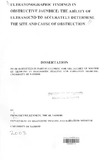| dc.contributor.author | Ngoseywe, Kennedy | |
| dc.date.accessioned | 2013-05-23T09:13:03Z | |
| dc.date.available | 2013-05-23T09:13:03Z | |
| dc.date.issued | 2008 | |
| dc.identifier.citation | Master of medicine in diagnostic imaging and radiation medicine | en |
| dc.identifier.uri | http://erepository.uonbi.ac.ke:8080/xmlui/handle/11295/24748 | |
| dc.description.abstract | The ability of ultrasound to accurately distinguish obstructive jaundice from
nonobstructive jaundice has made sonography the accepted screening procedure in the
jaundiced patient. Determination of the anatomic site of obstruction and its cause is
critical in the management of the jaundiced patient, whether traditional surgical
therapies are contemplated or newer "nonsurgical therapies like" radiologic methods are
instituted. Choosing the correct therapy and obtaining the best results from that therapy
usually require a precise knowledge of anatomic detail and the nature and extent of the
disease. The high accuracy and relative safety of direct cholangiography and newer
imaging methods such as magnetic resonance cholangiopancreatography have set a high
standard against which sonography must compete.
Objectives
The main objective was to evaluate the capacity of ultrasound in determining the site and
cause of obstructive jaundice.
Study design
A descriptive prospective study.
Setting
Kenyatta National Hospital and University Of Nairobi radiology departments.
Subjects
All patients with obstructive jaundice who had undergone U/S examination and another
diagnostic imaging test /surgery with which the results of U/S were compared.
Methods
A total of 40 patients with evidence of intrahepatic or extra hepatic obstruction were
entered prospectively into the study from June 2007 to April 2008.
Results
The site of obstruction was predicted in 26 patients (sensitivity of 65% and specificity
of 77%), but was indeterminate in 35% because of the inability to visualize the
complete biliary tract. The cause of obstruction was correctly predicted in 31 patients
(sensitivity of 78% and specificity of 72%) and was indeterminate in 22% (p<O.05).
Conclusion
Ultrasonography was accurate in differentiating obstructive from non obstructive jaundice
but was non specific in assigning a definite cause of obstruction and in predicting the site of
obstruction | en |
| dc.description.sponsorship | University of Nairobi | en |
| dc.language.iso | en | en |
| dc.title | Ultrasonographic findings in obstructive jaundice: the ability of ultrasound to accurately determine the site and cause of obstruction | en |
| dc.type | Thesis | en |
| dc.description.department | a
Department of Psychiatry, University of Nairobi, ; bDepartment of Mental Health, School of Medicine,
Moi University, Eldoret, Kenya | |
| local.publisher | Department of diagnostic imaging and radiation medicine University of Nairobi | en |

